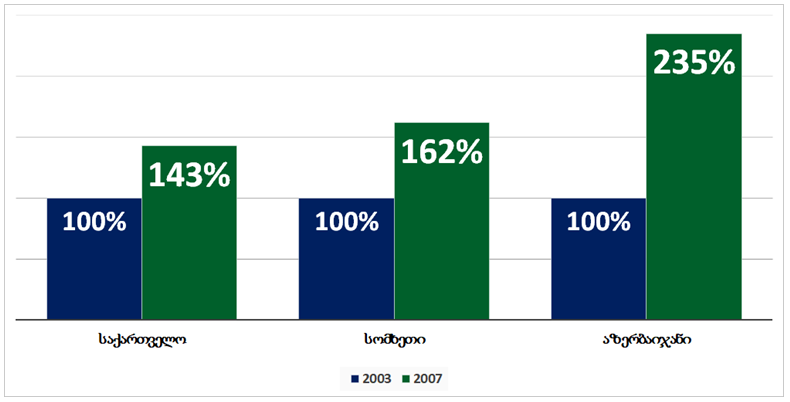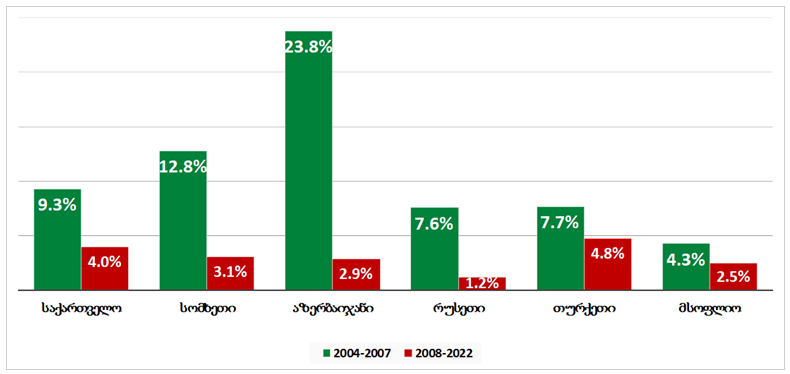Beka Liluashvili: “Economic growth in Armenia and Azerbaijan outpaced that of Georgia in 2004-2007.”
Verdict: FactCheck concludes that Beka Liluashvili’s statement is MOSTLY TRUE.
The average annual growth of the Georgian economy amounted to 9.3% from 2004 to 2007 whereas Armenia experienced an average growth of 12.8% while Azerbaijan saw a 23.7% growth. The cumulative growth for the respective countries over the aforementioned period was 43% for Georgia, 62% for Armenia and 135% for Azerbaijan.
This timeframe was characterised by heightened global economic activity with an average annual increase of 4.3%. However, this rate later diminished to 2.5% in the years spanning 2008 to 2022. A similar even larger reduction happened in the South Caucasus region as well as in the neighbouring countries of Turkey and Russia.
Whilst the leader of the For Georgia political party accurately states the factual information, he still omits one notable detail – the fact that global oil prices surged from USD 55 to USD 140, independent of Azerbaijan’s influence. This surge significantly contributed to Azerbaijan’s economic growth. Additionally, Azerbaijan substantially increased its oil extraction, export and began exploiting new infrastructure.
Considering the fact that the region generally experienced higher rates of economic growth in 2004-2007, it is true that Azerbaijan and Armenia experienced higher growth than Georgia. Whilst the statement underlined the threefold higher growth of Azerbaijan, the underlying factors were not listed. Thus, FactCheck concludes that Beka Liluashvili’s statement is MOSTLY TRUE.
Analysis:
During a recent appearance on the TV Pirveli Talk Show Reaktsia (Reaction), Beka Liluashvili, one of the leaders of the For Georgia party, discussed the economic growth achieved during the initial term of the United National Movement political party, stating (from 1:01:00): “The primary accomplishment of the UNM, regarding the economy, was the double-digit economic growth in 2007. Do you know the situation in the region back then? They merely sat on the regional growth trend in the first half of their power. Even Armenia experienced higher economic growth back then, during that period, whilst Azerbaijan witnessed a threefold higher economic growth.”
The rate of global economic growth was higher from 2004 to 2007 as compared to the subsequent years with the average global economy growth rate amounting to 4.3% during the period, eventually decreasing to 2.5% in the years spanning 2008 to 2022 according to World Bank data.
All three countries of the South Caucasus region experienced heightened economic growth from 2004 to 2007. The average annual growth in Georgia constituted 9.3%, Armenia marked a growth rate of 12.8% and Azerbaijan witnessed a 23.8% growth.
The analysis makes it evident that both of the aforementioned neighbouring countries outpaced Georgia regarding economic growth during the specified timeframe. Moreover, Georgia ranked third in terms of growth rate amongst these three countries throughout all four years mentioned above.
Graph 1: Economic Growth Rates in the South Caucasus Region

Source: World Bank
The aggregated real growth figures for Georgia, Armenia and Azerbaijan from 2004 to 2007 are 43%, 62% and 135%, respectively.
Graph 2: Cumulative Economic Growth in the South Caucasus Region in 2007 as Compared to 2003

GDP growth is shaped not only by the state’s economic policies but also by external factors. Smaller-scale countries cannot influence the trends in the global market and their economies may fluctuate regardless their production decisions.
Oil and gas production lead Azerbaijan’s economy, contributing over 85% to the country’s exports. The price of a barrel of oil increased two-point-five-fold from USD 55 to USD 140 in 2004-2007 at the current exchange rate. Azerbaijan’s oil export increased by 340% from 170,000 to 745,000 daily during the same period. The prices of gas also increased alongside oil products. The Baku-Tbilisi-Ceyhan oil pipeline was opened in 2006 and the South oil pipeline also known as Shah-Deniz - in 2007.
Contrarily, Armenia, whilst not being positively influenced by the surge in fossil fuel prices, nonetheless experienced a higher economic growth rate as compared to Georgia during the same period despite no oil or gas pipeline passing through its territory.
The two other neighbouring states of Georgia, Russia and Turkey, were also characterised by higher economic growth similar to Armenia and Azerbaijan between 2004 and 2007.
Graph 3: Average Annual Economic Growth Rate

Source: World Bank
Despite the average annual economic growth rate of Georgia reducing by 2.3, it, nonetheless, ranked third and the last amongst the South Caucasian countries in 2004-2007; however, the country later improved its position and ranked first in the subsequent years spanning 2008 to 2022 as the economic growth rates of Armenia and Azerbaijan displayed declines of 4.1 and 8.2, respectively.
Beka Liluashvili’s statement regarding the heightened economic growth in the region during the 2004-2007 timeframe, with Armenia and Azerbaijan outpacing the Georgian economy, is generally true. However, considering that Azerbaijan’s key contributor was the surge in oil prices, FactCheck evaluates the For Georgia party leader’s statement as MOSTLY TRUE.








